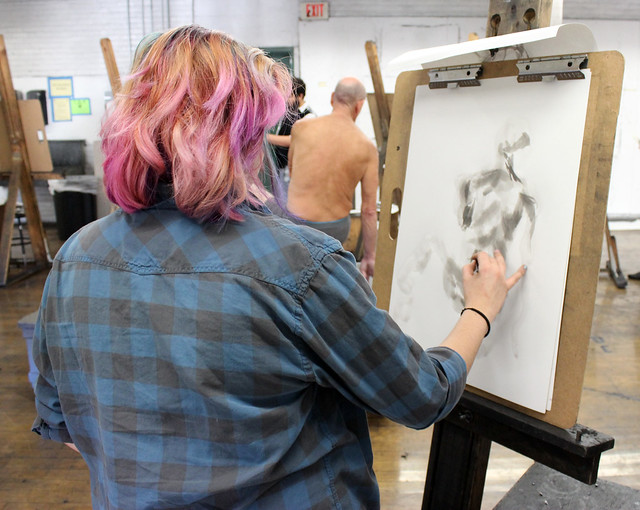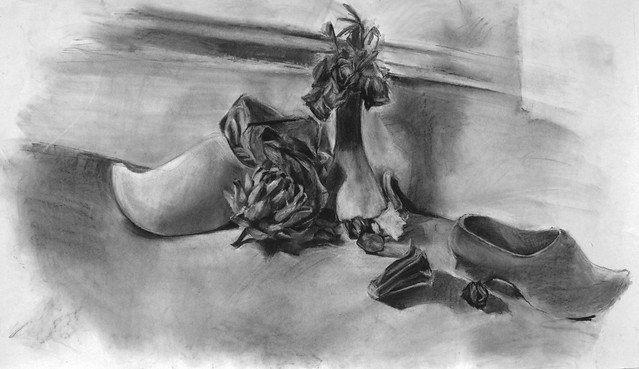Can You Put Unfinished Work in Your College Art Portfolio

"This yr, I'll be a junior in high school. It feels like this is my last year to improve my techniques earlier working on an art portfolio for college access…sometimes it'south too much pressure to think about how I'll be stacked up against many talented art students who are my age during the college and art schoolhouse submission procedure. Everyone is so wonderful and talented!
What are common mistakes in college fine art portfolio submissions? What shows the divergence between a weak fine art educatee and a strong art student? I have ane year left to prepare – what should I specifically focus on to improve my chances?"'
A potent fine art pupil will command not just technical mastery over their material, merely likewise be innovative and passionate in terms of their discipline matter and approach. On the flip side, you can have a weak student who may have good technique, just perhaps is working with field of study thing that is obvious and cliché.
A strong student's work will stand on it's own, and not look like it'south lifted from some other artist or style. A weaker student might copy something from somewhere else. Strong students are prolific and experimental with their fine art materials; they are willing to try out unusual methods for handling their fine art materials.
At the opposite terminate of the spectrum, a weaker student might use the same art materials all the time, and use them in a predictable, mutual mode.

There are a number of "classic" mistakes that I see over and over again when evaluating portfolios for higher. I tin can guarantee if that if you avoid these mistakes like the plague, that you will automatically have a major advantage over a significant portion of the other applicants.
Remember, admissions officers take looked at literally thousands of portfolios, and most of these mistakes are nil new to them. Making whatsoever of these mistakes will get you lot eliminated from the acceptance pile very quickly.
In conjunction to this list below, also exist certain to visit this video tutorial on how to prepare a portfolio for college admission. The tutorial goes into great depth near specific deportment and approaches you can focus on to better your chances in the competitive higher admissions procedure.
ane) Copying from photographs.
To a trained heart, it'due south more often than not glaringly obvious when something has been copied from a photograph. Cartoon from a photograph is a cheap shortcut.
Not only are the results always lousy, but copying from photographs will but develop bad habits that will be hard to "undo" later on. This article I wrote which states many reasons for why it's critical to draw from direct observation.
2) No anime, manga, fan art, or drawings of celebrities.
Catamenia. Don't even recall about it.
iii) Poor quality photographs of the art itself.
Invest the time and coin into photographing your artwork properly. Too oft I see terrible photographs of good artwork, which makes me nuts. With digital photography, this is affordable and easy to attain, it just takes time and labor.
This means properly cropped images, even lighting throughout the image, images that are in focus, etc. In the photograph of this oil painting below, in that location is a lot of glare on the left hand side of the photo, which makes it very difficult to come across what the actual painting really looks like.

4) Blank backgrounds.
Art students will oft create images focusing so much on their main discipline affair that they leave the background blank.
It's important to balance and distribute your attention to every foursquare inch of the artwork, merely very few students do this. Many volition intensely labor over tiny details in one surface area, and and so completely neglect other areas of the artwork, leaving them completely untouched.
Backgrounds do non have to be complicated, in fact, yous probably want your background to take a dorsum seat to your subject so that it's not distracting. Nonetheless, nothing is more than distracting than blank white paper that makes your drawing look unfinished.
Be the exception and work on the background as much as you lot piece of work on everything else in the epitome. Create backgrounds that are just as lively and engaging every bit the primary subject. If you don't like the groundwork yous're seeing behind your subject, take the time to create a set up with a background that is interesting to you.
The nature object in this educatee cartoon beneath is beautifully fatigued, but the groundwork is completely blank, making the drawing appear unresolved and empty in the background.

5) Placing your subject expressionless center on the page.
Composition is almost always ignored by students in their pieces for a college portfolio. This is largely because student don't even think about where they place their subject on the page. For the vast majority of art students, sticking the subject right in the middle of the page is the default reaction, which makes for a really boring and predictable limerick.
This article I wrote talks about specific strategies for creating a dynamic limerick that volition lead the viewer's eye throughout the unabridged artwork. Composition is critical to an artwork, and no amount of spectacular technique will save yous from a lousy composition.

Exist the exception and take the time to consider where you place your subject. 1 way to do this is to create thumbnail sketches in advance of creating the final drawing. This article I wrote talks most how to develop a drawing from sketch to finish.
Thumbnail sketches are a very quick fashion to piece of work out the placement of your subject area before you lot invest time on the final drawing. This video tutorial on drawing a cocky-portrait from life explains how to create effective thumbnail sketches.
vi) Don't rely on only yourself for feedback.
Many students brand the mistake of thinking that they tin can create their portfolios entirely on their ain. Unfortunately, many loftier school students are forced to teach themselves due to many schoolhouse fine art programs being cut back or non-real.
Take the initiative to seek out advice from an fine art teacher you trust, preferably one who has feel helping students with portfolios, and who tin offer you a aboveboard assessment of your work.
If you lot don't know anyone y'all tin can ask, we offer thirty minute video critiques on students preparing a college art portfolio for a fee. Get more information on purchasing a portfolio video critiques hither, and watch a sample critique below.
7) Having unfinished pieces.
In my feel, very few students in loftier schoolhouse know how to bring an artwork to full resolution. About artwork I encounter is nowhere most finished, and requires another two or three hours to exist fully resolved. Other times, its equally simple as filling in all the white areas then that no raw paper or canvas is showing.
Push button your pieces to full resolution, so that no stone is left untouched. This charcoal cartoon beneath is well washed, but the student didn't bring the charcoal right to the edge of the newspaper, making the piece look unfinished.

Artprof.orgis a free website for learning visual arts which features video tutorials, fine art critiques, and more.
Related articles
"What is the purpose of a degree in art?"
"What should you lot include in an art portfolio for art schoolhouse or college?"
"When you have a fine arts degree, what do you practise for the balance of your life?"
"How do y'all preserve your creative integrity within the strict fourth dimension limitations in an academic setting?"
"Is art education really so popular in western countries?"
"What do y'all practise after you've finished formalized preparation?"
"Should art students study abroad even if it distracts from job preparation?"
"Who should you make art for, yourself or your professor?
Source: https://claralieu.wordpress.com/2013/08/19/ask-the-art-professor-what-are-common-mistakes-in-college-portfolio-submissions/
0 Response to "Can You Put Unfinished Work in Your College Art Portfolio"
Post a Comment